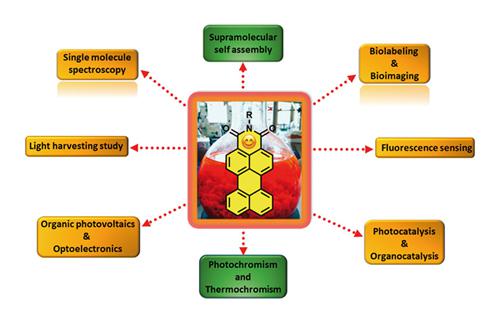Perylene Monoimide as a Versatile Fluoroprobe: The Past, Present, and Future
引用次数: 6
Abstract
Abstract Perylene dyes have transcended their role as simple colorants and have been reinvigorated as functional dyes. Based on the substitution at the peri-position by six-membered carboxylic imides, the perylene family is principally embellished with perylene diimides (PDIs) and perylene monoimides (PMIs). Perylene dyes are widely acclaimed and adorned on account of their phenomenal thermal, chemical, and photostability juxtaposed with their high absorption coefficient and near-unity fluorescence quantum yield. Although symmetric PDIs have always been in the limelight, their asymmetrical counterpart PMI is already rubbing shoulders, thanks to the consistent efforts of several scientific minds. Recently, there has been an upsurge in engendering PMI-based versatile organic architectures decked with intriguing photophysical properties and pertinent applications. In this review, the synthesis and photophysical features of various PMI-based derivatives along with their relevant applications in the arena of organic photovoltaics, photocatalysis, self-assembly, fluorescence sensing, and bio-imaging are accrued and expounded, hoping to enlighten the less delved but engrossing realm of PMIs. Table of content: 1 Introduction 2 Advantages of PMI over PDI 3 Challenges in Working with PMI and Ways to Overcome 4 Various Aspects of Reactivity of Different Positions 5 Synthesis of the PMI core 6 Synthesis of PMI Derivatives 6.1 Bromination of PMI 6.2 Synthesis of PMI Derivatives using Coupling Reactions 6.2.1 Suzuki Coupling 6.2.2 Sonogashira Coupling 6.2.3 Buchwald–Hartwig Coupling Reaction 6.3 Nucleophilic Substitution Reactions 6.4 Peri-Annulation Reaction 7 Photophysical Properties of PMI 8 Singlet Fission Properties 9 Förster Resonance Energy Transfer with PMI 10 Symmetry Breaking Charge Transfer Properties 11 Panchromatic Light Absorption Properties of PMI 12 Acid/Base Sensitivity of PMI 13 NIR-Absorbing PMI 14 Achieving of Triplet State Using PMI 15 Solid-State Emissive PMI 16 Thermo-Responsive Materials with PMI 17 Photo-Responsive PMI Derivatives 18 Electrochemical Properties of Rylene Derivative 19 Self-Assembling Properties of PMI Derivatives 20 Applications of PMI in Solar Cells 21 PMIs in Bulk Heterojunction Solar Cells 22 PMIs in Dye-Sensitized Solar Cells 23 PMI as a Fluorescent Reporter 23.1 Application of PMI Derivatives for Bio-Imaging 23.2 Hydrophilic PMIs for Bio-Imaging 23.3 Aggregated PMI as NIR-Emissive Fluoroprobe for Bio-Imaging 24 Photocatalytic Hydrogen Generation using PMI 25 PMI-Based Organocatalysis 26 PMI Derivatives for Single-molecule Spectroscopy 27 Host–Guest Chemistry with PMI 28 Conclusions and Outlook

苝单酰亚胺作为一种通用荧光探针:过去、现在和未来
摘要苝染料已经超越了其作为简单着色剂的作用,并作为功能染料得到了振兴。基于六元羧酸酰亚胺在邻位的取代,苝家族主要用苝二亚胺(PDIs)和苝单酰亚胺(PMIs)修饰。苝染料因其惊人的热稳定性、化学稳定性和光稳定性,以及其高吸收系数和接近单位的荧光量子产率而广受赞誉和装饰。尽管对称的PDI一直备受关注,但由于一些科学头脑的持续努力,它们的不对称对应物PMI已经开始崭露头角。最近,产生具有有趣的光物理性质和相关应用的基于PMI的多功能有机建筑的热潮兴起。本文综述并阐述了各种基于PMI的衍生物的合成、光物理特性及其在有机光伏、光催化、自组装、荧光传感和生物成像等领域的相关应用,希望能对PMI这一不太深入但引人入胜的领域有所启发。目录:1简介2 PMI相对于PDI的优势3使用PMI的挑战和克服方法4不同位置反应性的各个方面5 PMI核心的合成6 PMI衍生物的合成6.1 PMI的溴化6.2使用偶联反应合成PMI衍生物6.2.1铃木偶联6.2.2 Sonogashira偶联6.2.3 Buchwald-Hartwig偶联反应6.3亲核取代反应6.4环氧化反应7 PMI的光物理性质8单核裂变性质9具有PMI的Förster共振能量转移10对称性破坏电荷转移性质11 PMI的全色光吸收性质12 PMI的酸/碱敏感性13 NIR吸收PMI 14使用PMI 15固态实现三重态具有PMI的发射性PMI 16热响应材料17光响应性PMI衍生物18 Rylene衍生物的电化学性质19 PMI衍生物的自组装性质20 PMI在太阳能电池中的应用21体异质结太阳能电池中22染料敏化太阳能电池中23 PMI作为荧光报告物23.1 PMI衍生物在生物成像中的应用23.2用于生物成像的亲水性PMI 23.3聚集的PMI作为近红外发射荧光探针用于生物成像24使用PMI的光催化制氢25基于PMI的有机催化26用于单分子光谱的PMI衍生物27具有PMI的主客体化学28结论和展望
本文章由计算机程序翻译,如有差异,请以英文原文为准。
求助全文
约1分钟内获得全文
求助全文

 求助内容:
求助内容: 应助结果提醒方式:
应助结果提醒方式:


